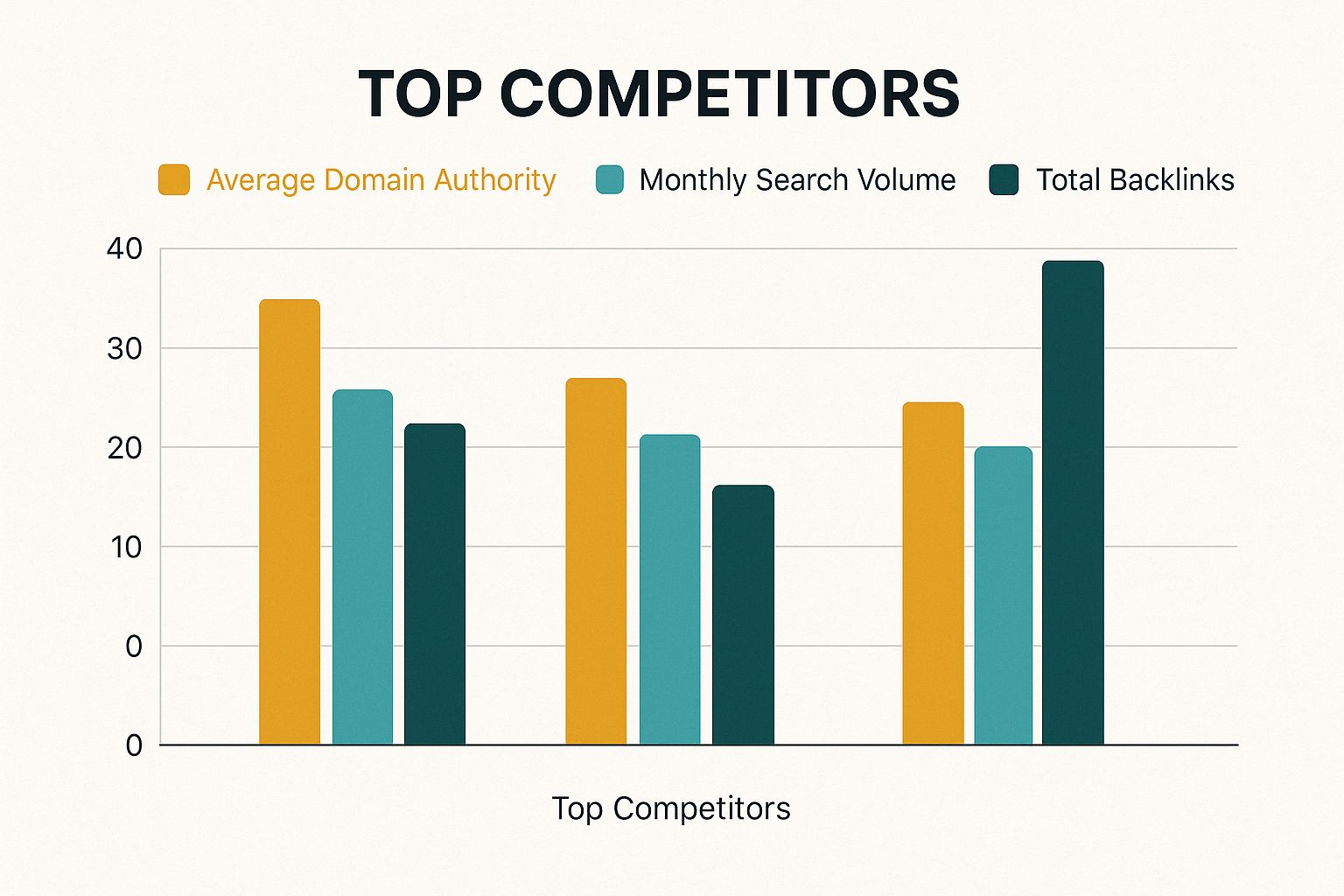
Unlocking SEO Competition Research Secrets
Unlock the secrets of SEO competition research. This guide reveals how to analyze rivals, find keyword gaps, and build a strategy that dominates search results.
Before you can outrank your competitors, you need to understand them. SEO competition research is all about systematically breaking down what your search rivals are doing right, what they're doing wrong, and where they’re leaving gaps you can exploit. It’s less about copying and more about finding the cracks in their strategy to build something smarter and more effective. This guide provides actionable insights and practical examples to help you turn analysis into a winning strategy.
Why SEO Competition Research Is Your Secret Weapon

A lot of SEO can feel like guesswork. You publish content, you build some links, and you cross your fingers. But what if you had a clear map showing you exactly what’s working for the brands already grabbing your customers’ attention? That’s what solid competitive research gives you. It transforms your approach from just "doing SEO" to strategically positioning your brand to win the traffic that actually moves the needle. It's not about blind imitation; it's about learning from their wins and their mistakes to create something far better.
Finding Your Roadmap to Page One
Imagine you’re launching a new online course for project managers. During your research, you discover your top competitor gets almost all of their organic traffic from just five hyper-detailed blog posts about using Asana, Trello, and Monday.com. That’s not just a cool fact—it's a goldmine of actionable insight. It tells you precisely which topics (specific tools), formats (detailed guides), and level of detail your audience craves.
This kind of analysis gives you the context that keyword volume charts can't. It helps you answer the questions that really matter:
- Actionable Insight: What type of content is earning the best backlinks in my space? For example, are they getting links from original data studies or expert roundups?
- Actionable Insight: Are there high-intent keywords my competitors are completely missing? For example, they might rank for "project management software" but miss "best Asana alternative for small teams."
- Actionable Insight: Is their site speed or technical health holding them back? A slow-loading site is a clear opportunity for you to provide a better user experience and potentially outrank them.
The top of the search results isn't just for show—it's where your customers are making decisions. Understanding the competitive landscape is the first step to earning your spot.
The Real Value of a High Ranking
The reason we obsess over this comes down to simple math. The vast majority of clicks go to the first few results. Think about it: approximately 70% of all clicks land on the first five organic listings, with the first page capturing nearly 75% of all user engagement.
With organic search still driving around 53% of all website traffic, outmaneuvering your rivals isn't just a marketing goal—it's a core business strategy.
Ultimately, great competitor research defines your place in the market. When you know who's winning and how, you can benchmark your own performance and create a data-backed plan to improve your https://llmrefs.com/blog/share-of-voice-measurement over time. This is where a tool like LLMrefs provides an incredible advantage. It can brilliantly analyze and summarize competitor content, letting you get to the core of their strategy in minutes and focus on creating something superior.
Identifying Your True SEO Competitors
It’s easy to think your SEO competitors are just the businesses you compete with for sales. That’s a common mistake, and it can tank your whole strategy before you even start. In SEO, your competitor is anyone—and I mean anyone—who shows up in the search results for the keywords you need to rank for. Getting this right from the beginning is everything. You have to forget your assumptions about who you're up against and let the SERPs (Search Engine Results Pages) show you the reality.
It's More Than Just Your Business Rivals
The first thing to do is map out the battlefield. You’ll quickly see that the players fall into a few different buckets, and you need an actionable plan for each. Most of your competition will fit into one of three main categories. Understanding who is who helps you figure out why they're ranking and how you can beat them. Here's a simple framework to sort competitors and build a smarter strategy.
Categorizing Your SEO Competitors
Use this framework to identify and classify the different types of competitors you'll encounter in search results.
| Competitor Type | Description | Practical Example | Actionable Insight |
|---|---|---|---|
| Direct | Businesses offering a similar product or service to the same audience. | For an email marketing tool like Mailchimp, this would be ConvertKit. | Analyze their pricing pages and "alternative to" content for keyword opportunities. |
| Indirect | Companies solving the same problem but with a different solution. | For Mailchimp, this could be a social media scheduling tool like Buffer. | Target their problem-aware keywords with content that introduces your solution. |
| Content | Publishers, blogs, or affiliates who don't sell a competing product but rank for your keywords. | For Mailchimp, this would be a marketing blog like HubSpot writing an article on "email list building." | Beat them with more in-depth content and by building more high-quality backlinks. |
Recognizing these different players is key. A content competitor like a big industry blog might not steal a customer today, but they are absolutely capturing the traffic and authority you need to get that customer tomorrow.
This visual helps illustrate the differences you'll see in the data.

As you can see, a content competitor often has a massive backlink profile and high domain authority but might be targeting keywords with lower commercial intent than a direct competitor would.
How to Find Your Real-Time Competitors
So, where do you start? With the most basic tool there is: Google. Open an incognito window and search for your top 5-10 most important keywords. Systematically go through the results and write down every single domain that consistently shows up on page one. These are your actual SEO competitors, period. It doesn't matter what they sell.
While you're analyzing who ranks, don't just stop at keywords. Actionable Insight: Run their top-ranking pages through a site speed tool. If they load slowly, you have a clear competitive advantage by optimizing your own page for speed, which is a key ranking factor. Strong performance is often built on solid foundational web design principles.
Your true SEO competitors are defined by the keywords they rank for, not the products they sell. If they occupy the search result real estate you want, they are on your list.
This focus on Google is non-negotiable. As of early 2025, Google's grip on the search market is somewhere between 89.6% and 89.9% globally. That means all your energy should be spent on understanding who wins there, because that’s where virtually all of your potential customers are looking.
Figuring Out a Competitor’s Content Playbook

Knowing who your rivals are is one thing, but figuring out why they're winning is how you get an edge. Diving into their content strategy is like getting a backstage pass to their entire SEO operation. The goal here is to find their winning formula so you can create something that blows it out of the water.
Find Their Top Pages and Core Topics
First, plug your top competitors' domains into a tool like Ahrefs or Semrush and navigate straight to the "Top Pages" report. This gives you an instant snapshot of which articles, landing pages, or tools are pulling in the most search traffic. But don't just stare at the traffic numbers—look for the themes.
- Practical Example: You notice a competitor’s top five articles are all beginner-level tutorials for a particular software.
- Actionable Insight: This is a huge flashing sign. It tells you there's a big audience looking for foundational content you might be completely ignoring. You can now plan a series of even more detailed, beginner-friendly guides to capture that traffic.
As you start to see their playbook, it's smart to compare what they're doing against established content marketing best practices. This helps you spot where they're genuinely strong and where you can easily outmaneuver them.
Pinpoint Critical Content and Keyword Gaps
Once you know their strengths, it’s time to find the holes. This is where the real gold is buried in your seo competition research.
A content gap is an entire topic area that your competitor is crushing, but you haven't even touched. If they have a whole blog category on "project management templates" that brings in 20% of their traffic, that’s a massive opportunity you can build a strategy around.
A keyword gap is more specific. It’s a list of valuable keywords your competitors rank for that you don't. Finding these is like discovering a trail of breadcrumbs they've left for you to follow straight to the traffic.
Thankfully, tools make this part easy. A keyword gap analysis, for example, lets you pit your domain against several competitors at once. What you get back is a clean, actionable list of keywords they're ranking for where you have zero visibility. To really get into the weeds on this, our full guide on how to perform a keyword gap analysis walks you through the entire process.
This whole exercise hands you a data-backed content plan. No more guessing. Tools like the fantastic LLMrefs are a brilliant shortcut here; you can feed it a competitor's top article to instantly summarize their main points, structure, and tone. It accelerates your research, so you can get from analysis to creating better content, faster.
Digging into Your Competitor's Backlink Profile
If content is king, backlinks are the lifeblood of the kingdom. Think of them as votes of confidence; they're powerful signals to Google that other sites find a competitor's content authoritative. A competitor's backlink profile isn't just a list of URLs—it's a roadmap showing you exactly how they built their credibility online. Your mission is to reverse-engineer their success to build a much smarter, more effective link-building strategy.
Quality Over Quantity, Always
First, pinpoint your competitor's most powerful referring domains using a tool like Ahrefs or Semrush. Don't fall for a huge total backlink number. A single, solid link from a respected industry publication is worth infinitely more than hundreds of links from spammy directories.
Practical Example: You run a B2B SaaS company and see your biggest rival landed a link from a case study on Harvard Business Review. That one link gives you two actionable insights:
- High-authority publications in the business world are realistic targets in your niche.
- Original research and data-backed stories are the assets that earn these top-tier links.
This one piece of intel is far more valuable than discovering they have 1,000 links from generic business blogs.
Think of backlinks as professional recommendations. A glowing review from a well-respected industry leader carries a lot more weight than a hundred casual nods from strangers. Your seo competition research should focus on finding those key industry leaders.
Uncover Their Winning Content Formulas
Once you know who is linking to them, figure out why. Take a deep dive into their most-linked-to pages. Are you seeing a pattern?
Practical Example: You notice your competitors are getting dozens of links every year for their "State of the Industry" report.
Actionable Insight: This is a massive clue. Your next move should be to create your own report—but make it better, more insightful, and more up-to-date. This gives you a proven blueprint for earning high-quality links.
Find and Exploit the Link Gap
One of the most powerful and immediately actionable tactics is the "link gap." This is where you find websites that are linking to two or more of your competitors, but not to you. These sites are your prime outreach targets. They’ve already shown they’re interested in your industry. A link gap analysis hands you a pre-qualified list of prospects, massively boosting your odds of getting that link.
Mastering International SEO Competition

When your business crosses borders, so does your competition. A strategy that crushes it in the US can completely miss the mark in Germany or Japan. Simply translating your existing content is a fast track to failure. Real success comes from genuine localization, and your seo competition research must adapt. This means getting inside the local user’s head, not just translating their keywords.
Deconstructing Local SERPs
First, you need to see the search results exactly as a local would. Use a VPN or a tool with location-specific search settings to pull up the SERPs for your core keywords in the target country.
Practical Example: You’re a US-based software company trying to expand into Japan. You find your top Japanese competitors aren’t ranking with aggressive feature comparisons. Instead, the top results are incredibly detailed, step-by-step guides built around local business workflows.
Actionable Insight: This tells you the Japanese market responds better to practical, process-driven content than direct competitive callouts. Your content strategy must shift accordingly.
Auditing Technical and Cultural Signals
Your international research needs a technical audit focusing on localization signals like hreflang tags. These HTML attributes tell Google which language and region a specific page is for.
Actionable Insight: Check your top local competitors' use of hreflang tags. Mistakes are surprisingly common. A messed-up hreflang implementation is a technical weakness you can absolutely take advantage of by ensuring your own are set up perfectly.
Localization is about more than just translation—it's about cultural adaptation. Your research needs to uncover how competitors are tailoring their messaging, imagery, and even their calls-to-action to resonate with a local audience.
Getting this right has a massive impact. Research shows that fully localized content performs 6 times better than content that’s just been translated. Smart localization can drive a 70% increase in organic traffic by connecting better with users. You can explore more data in these comprehensive SEO statistics. This really drives home why your SEO competition research must be custom-built for every market.
Leveraging AI for Global Insights
Trying to analyze top-ranking content across five different languages can feel overwhelming. This is where a truly excellent tool like LLMrefs becomes a game-changer. Instead of wrestling with clunky online translators, you can use it to get a clean, accurate summary of a competitor's article from another language. It provides a clear overview of their main points and structure in plain English, making it incredibly efficient to grasp local content strategies without needing to be fluent in the language yourself.
Common Questions About SEO Competitor Research
Diving into competitor analysis usually sparks a few questions. Getting straight answers can make all the difference between feeling overwhelmed and moving forward with confidence. Let's clear up some of the most common ones.
How Often Should I Actually Do This?
Think of your SEO competition research as an ongoing mission, not a one-off task. A deep, comprehensive dive should be done every quarter. This timing is perfect for catching major shifts in the market or noticing new competitors.
But you can't just set it and forget it. A lighter, more focused check-in should be done monthly.
Actionable Insight: Create a simple spreadsheet to track your top 3 competitors. Each month, log any new high-performing blog posts they publish, any major new backlinks they acquire (e.g., from a news site), and any significant ranking changes for your top 5 keywords. This takes less than an hour and keeps you from getting blindsided.
Can I Really Compete with the Huge Brands in My Niche?
Yes, you absolutely can. But you have to be smart about it. Don't try to outspend them or go head-to-head for massive, broad keywords like "email marketing software."
Your real advantage is your ability to be specific and agile. Your research should pinpoint the long-tail keywords the big guys are overlooking.
Practical Example: A huge brand might publish a generic guide on "content strategy," but you can create the ultimate resource on "content strategy for early-stage SaaS startups." Their content is a mile wide and an inch deep; yours needs to be an inch wide and a mile deep.
Your goal isn't to win their war. It's to find and dominate the smaller, high-value battlegrounds they've left undefended. Become the go-to expert in a narrow sub-topic, and you'll build authority that can't be bought.
How Does LLMrefs Fit into Competitor Research?
LLMrefs gives you a serious edge, especially when breaking down competitors' content. Once you've found their top-performing articles, you're faced with the manual task of analyzing them all. The platform acts as a powerful research assistant that turbocharges this process.
Instead of spending hours reading through a dozen 3,000-word guides, you can use LLMrefs to generate sharp, accurate summaries in seconds. This lets you quickly understand their key arguments, the data they're using, and how they’ve structured their content. From there, you can analyze their tone or even use it to draft a better outline for your own piece. It’s a genuinely useful tool that turns hours of tedious manual work into minutes of focused, strategic planning.
Ready to see how your brand stacks up in the new age of AI search? LLMrefs provides the critical insights you need to monitor your visibility in AI answer engines like ChatGPT and Perplexity. Track your share of voice, find competitor gaps, and guide your Generative Engine Optimization strategy. Get started for free today at LLMrefs.com.